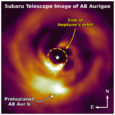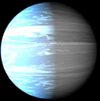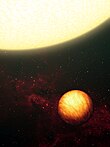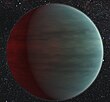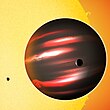List of hottest exoplanets
Topic: Astronomy
 From HandWiki - Reading time: 7 min
From HandWiki - Reading time: 7 min
Short description: none
This is a list of the hottest exoplanets so far discovered, specifically those with temperatures greater than 2,500 K (2,230 °C; 4,040 °F). For comparison, the hottest planet in the Solar System is Venus, with a temperature of 737 K (464 °C; 867 °F).
List
Methods for finding temperature:
- Teff: Measured effective temperature.
- Teq: The temperature of the planet has not been measured, so it is listed with the calculated equilibrium temperature.
| Image
(Or artistic representation) |
Name | Temperature (K) | Mass | Method | Notes | References |
|---|---|---|---|---|---|---|
| KELT-9b | 4,643±26 | 2.88 Jupiter mass | Teff | Hottest known exoplanet, with a temperature comparable to K-type stars. | [1] | |
| AB Aurigae b | 3,800 | 9-12 MJ | [2][3] | |||
| 55 Cancri e (Janssen) | 3,771+669 −520 |
7.99 M⊕ | [4] | |||
| TOI-2109b | 3,631±69 | 5.02 Jupiter mass | [5] | |||
| WASP-189b | 3,435±27 | 1.99 Jupiter mass | [6] | |||
| TOI-1518b | 3,237±59 | <2.3 Jupiter mass | [7] | |||
| WASP-103b | 3,205±136 | 1.455 Jupiter mass | [8] | |||
| KELT-16b | 3,190±61 | 2.75 Jupiter mass | [9] | |||
| WASP-12b | 3,128±66 | 1.465 Jupiter mass | This planet is so close to its parent star that its tidal forces are distorting it into an egg shape. | [10] | ||
| WASP-33b | 3,108±113 | 2.093 Jupiter mass | [8] | |||
| WASP-18b | 3,067±104 | 10.20 Jupiter mass | [8] | |||
| MASCARA-1b | 3,062±67 | 3.7 Jupiter mass | [11] | |||
| HATS-70b | 2,730+140 −160 |
12.9 Jupiter mass | Teq | [12] | ||
| WASP-100b | 2,710 | 2.03 Jupiter mass | Teff | [13] | ||
| HIP 78530 b | 2,700±100 | 23 Jupiter mass | Likely a brown dwarf. | [14] | ||
| MASCARA-5b | 2,700 | 3.12 Jupiter mass | [15] | |||
| WASP-76b | 2,670 (dayside) | 0.92 Jupiter mass | In this tidally locked planet where winds move 18,000 km/h, molten iron rains from the sky due to daytime temperatures exceeding 2,400 °C (2,670 K).[16][17] | [18] | ||
| HAT-P-7b | 2,667±57 | 1.682 Jupiter mass | [19] | |||
| GQ Lupi b | 2,650±100 | 20 Jupiter mass | Likely a brown dwarf. | [20] | ||
| TOI-2260 b | 2,609±86 | Teq | [12] | |||
| CT Chamaelontis b | 2,600±250 | 17 Jupiter mass | Teff | Likely a brown dwarf. | [21] | |
| HAT-P-70b | 2,562+43 −52 |
6.78 Jupiter mass | Teq | [12] | ||
| Kepler-13b | 2,550±80 (2277 °C) | 9.78 Jupiter mass | [12] | |||
| The following well-known planets are listed for the purpose of comparison. | ||||||
| Kepler-10b | 2,130+60 −120 (1,857 °C) |
4.6 M⊕ | Teq | [22] | ||
| TrES-4b | 1,782±29 (1,509 °C) | 0.919 Jupiter mass | One of the largest known exoplanets. | [23] | ||
| CoRoT-7b | 1,756±27 (1,483 °C) | 5.74 M⊕ | [24] | |||
| Upsilon Andromedae b (Saffar) | 1,673 (1,400 °C) | 1.7 Jupiter mass | Teff | [25][26] | ||
| WASP-17b (Ditsö̀) | 1,550+170 −200 (1,277 °C) |
0.512 Jupiter mass | With a density of about 0.08 g/cm³,[27] it is one of the puffiest exoplanets known. | [28] | ||
| HD 209458 b (Osiris) | 1,499±15 (1,226 °C) | 0.682 Jupiter mass | [29][28] | |||
| TrES-2b | 1,466±9 (1,193 °C) | 1.253 Jupiter mass | Teq | The darkest exoplanet known, reflecting less than 1% its star's light. | [30] | |
| Beta Pictoris b | 1,451±15 (1,178 °C) | 11.729 Jupiter mass | [31][32] | |||
| 51 Pegasi b (Dimidium) | 1,265 (992 °C) | 0.46 Jupiter mass | The first exoplanet discovered orbiting a main-sequence star. | |||
| Kepler-20e | 1,004±14 (735 °C) | <0.76 M⊕ | The first planet smaller than Earth discovered after PSR B1257+12 b. | [33] | ||
| Venus (for reference) | 735 (462 °C) | 0.815 M⊕ | Hottest planet in the Solar System. | [34] | ||
Unconfirmed candidates
These planet candidates have not been confirmed.
| Image
(Or artistic representation) |
Name | Temperature (K) | Mass | Method | Notes and references |
|---|---|---|---|---|---|
| Kepler-70b | 7,662 | 0.44 M⊕ | Teq | [lower-alpha 1] | |
| Kepler-70c | 6,807 | 0.655 M⊕ | [lower-alpha 2] | ||
| Vega b | 3,250 | 21.9 M⊕ | [35][lower-alpha 3] |
Notes
- ↑ Assuming albedo of 0.1
- ↑ Assuming albedo of 0.1
- ↑ Assuming bond albedo of 0.25
References
- ↑ Jones, K. et al. (October 2022). "The stable climate of KELT-9b". Astronomy & Astrophysics 666: A118. doi:10.1051/0004-6361/202243823. Bibcode: 2022A&A...666A.118J.
- ↑ Zhou, Yifan; Sanghi, Aniket; Bowler, Brendan P.; Wu, Ya-Lin; Close, Laird M.; Long, Feng; Ward-Duong, Kimberly; Zhu, Zhaohuan et al. (2022-07-01). "HST/WFC3 Hα Direct-imaging Detection of a Pointlike Source in the Disk Cavity of AB Aur". The Astrophysical Journal Letters 934 (1): L13. doi:10.3847/2041-8213/ac7fef. ISSN 2041-8205. Bibcode: 2022ApJ...934L..13Z.
- ↑ Currie, Thayne; Lawson, Kellen; Schneider, Glenn; Lyra, Wladimir; Wisniewski, John; Grady, Carol; Guyon, Olivier; Tamura, Motohide et al. (June 2022). "Images of embedded Jovian planet formation at a wide separation around AB Aurigae" (in en). Nature Astronomy 6 (6): 751–759. doi:10.1038/s41550-022-01634-x. ISSN 2397-3366. Bibcode: 2022NatAs...6..751C. https://www.nature.com/articles/s41550-022-01634-x.
- ↑ Mercier, Samson J. et al. (November 2022). "Revisiting the Iconic Spitzer Phase Curve of 55 Cancri e: Hotter Dayside, Cooler Nightside, and Smaller Phase Offset". The Astronomical Journal 164 (5): 204. doi:10.3847/1538-3881/ac8f22. Bibcode: 2022AJ....164..204M.
- ↑ Wong, Ian et al. (December 2021). "TOI-2109: An Ultrahot Gas Giant on a 16 hr Orbit". The Astronomical Journal 162 (6): 256. doi:10.3847/1538-3881/ac26bd. Bibcode: 2021AJ....162..256W.
- ↑ Lendl, M. et al. (November 2020). "The hot dayside and asymmetric transit of WASP-189 b seen by CHEOPS". Astronomy & Astrophysics 643: A94. doi:10.1051/0004-6361/202038677. Bibcode: 2020A&A...643A..94L.
- ↑ Cabot, Samuel H. C. et al. (November 2021). "TOI-1518b: A Misaligned Ultra-hot Jupiter with Iron in Its Atmosphere". The Astronomical Journal 162 (5): 218. doi:10.3847/1538-3881/ac1ba3. Bibcode: 2021AJ....162..218C.
- ↑ 8.0 8.1 8.2 Pass, Emily K. et al. (October 2019). "Estimating dayside effective temperatures of hot Jupiters and associated uncertainties through Gaussian process regression". Monthly Notices of the Royal Astronomical Society 489 (1): 941–950. doi:10.1093/mnras/stz2226. Bibcode: 2019MNRAS.489..941P.
- ↑ Mancini, L. et al. (January 2022). "The ultra-hot-Jupiter KELT-16 b: dynamical evolution and atmospheric properties". Monthly Notices of the Royal Astronomical Society 509 (1): 1447–1464. doi:10.1093/mnras/stab2691. Bibcode: 2022MNRAS.509.1447M.
- ↑ Owens, Niall et al. (May 2021). "Phase curve and variability analysis of WASP-12b using TESS photometry". Monthly Notices of the Royal Astronomical Society: Letters 503 (1): L38–L46. doi:10.1093/mnrasl/slab014. Bibcode: 2021MNRAS.503L..38O.
- ↑ Hooton, M. J. et al. (February 2022). "Spi-OPS: Spitzer and CHEOPS confirm the near-polar orbit of MASCARA-1 b and reveal a hint of dayside reflection". Astronomy & Astrophysics 658: A75. doi:10.1051/0004-6361/202141645. Bibcode: 2022A&A...658A..75H.
- ↑ 12.0 12.1 12.2 12.3 "Planetary Systems". https://exoplanetarchive.ipac.caltech.edu/cgi-bin/TblView/nph-tblView?app=ExoTbls&config=PS.
- ↑ Martin, Pierre-Yves (1995). "Catalogue of Exoplanets" (in en). Extrasolar Planets Encyclopaedia. https://exoplanet.eu/catalog/all_fields/.
- ↑ Lachapelle, François-René et al. (March 2015). "Characterization of Low-mass, Wide-separation Substellar Companions to Stars in Upper Scorpius: Near-infrared Photometry and Spectroscopy". The Astrophysical Journal 802 (1): 61. doi:10.1088/0004-637X/802/1/61. Bibcode: 2015ApJ...802...61L.
- ↑ "Scientists uncover a 'hellish' planet so hot it could vaporize most metals". CNET. April 27, 2021. https://www.cnet.com/news/scientists-uncover-a-hellish-planet-so-hot-it-could-vaporize-most-metals/. Retrieved April 27, 2021.
- ↑ Ehrenreich, David; Lovis, Christophe; Allart, Romain; Osorio, María Rosa Zapatero; Pepe, Francesco; Cristiani, Stefano; Rebolo, Rafael; Santos, Nuno C. et al. (2020-04-30). "Nightside condensation of iron in an ultra-hot giant exoplanet". Nature 580 (7805): 597–601. doi:10.1038/s41586-020-2107-1. ISSN 0028-0836. PMID 32161364. Bibcode: 2020Natur.580..597E.
- ↑ "Wasp-76b: The exotic inferno planet where it 'rains iron'" (in en-GB). 2020-03-11. https://www.bbc.com/news/science-environment-51828871.
- ↑ "WASP 76b – A World with Iron Rain". March 17, 2020. https://cosmoquest.org/x/2020/03/wasp-76b-a-world-with-iron-rain/.
- ↑ Wong, Ian; Knutson, Heather A.; Kataria, Tiffany; Lewis, Nikole K.; Burrows, Adam; Fortney, Jonathan J.; Schwartz, Joel; Shporer, Avi et al. (2016-06-01). "3.6 and 4.5 μm Spitzer Phase Curves of the Highly Irradiated Hot Jupiters WASP-19b and HAT-P-7b". The Astrophysical Journal 823 (2): 122. doi:10.3847/0004-637X/823/2/122. ISSN 0004-637X. Bibcode: 2016ApJ...823..122W.
- ↑ Neuhäuser, R. et al. (June 2008). "Astrometric and photometric monitoring of GQ Lupi and its sub-stellar companion". Astronomy and Astrophysics 484 (1): 281–291. doi:10.1051/0004-6361:20078493. Bibcode: 2008A&A...484..281N.
- ↑ Schmidt, T. O. B. et al. (November 2008). "Direct evidence of a sub-stellar companion around CT Chamaeleontis". Astronomy and Astrophysics 491 (1): 311–320. doi:10.1051/0004-6361:20078840. Bibcode: 2008A&A...491..311S.
- ↑ Esteves, Lisa J.; De Mooij, Ernst J. W.; Jayawardhana, Ray (2015-05-12). "Changing Phases of Alien Worlds: Probing Atmospheres of Kepler Planets with High-Precision Photometry". The Astrophysical Journal 804 (2): 150. doi:10.1088/0004-637X/804/2/150. ISSN 1538-4357. Bibcode: 2015ApJ...804..150E.
- ↑ Daemgen, S.; Hormuth, F.; Brandner, W.; Bergfors, C.; Janson, M.; Hippler, S.; Henning, Th (May 2009). "Binarity of Transit Host Stars - Implications on Planetary Parameters". Astronomy & Astrophysics 498 (2): 567–574. doi:10.1051/0004-6361/200810988. ISSN 0004-6361. Bibcode: 2009A&A...498..567D.
- ↑ Barros, S. C. C.; Almenara, J. M.; Deleuil, M.; Diaz, R. F.; Csizmadia, Sz.; Cabrera, J.; Chaintreuil, S.; Collier Cameron, A. et al. (2014-09-01). "Revisiting the transits of CoRoT-7b at a lower activity level". Astronomy and Astrophysics 569: A74. doi:10.1051/0004-6361/201423939. ISSN 0004-6361. Bibcode: 2014A&A...569A..74B. https://ui.adsabs.harvard.edu/abs/2014A&A...569A..74B.
- ↑ Piskorz, Danielle; Benneke, Björn; Crockett, Nathan R.; Lockwood, Alexandra C.; Blake, Geoffrey A.; Barman, Travis S.; Bender, Chad F.; Carr, John S. et al. (2017-08-01). "Detection of Water Vapor in the Thermal Spectrum of the Non-transiting Hot Jupiter Upsilon Andromedae b". The Astronomical Journal 154 (2): 78. doi:10.3847/1538-3881/aa7dd8. ISSN 1538-3881. Bibcode: 2017AJ....154...78P.
- ↑ Harrington, J.; Hansen, B.; Luszcz, S.; Seager, S.; Deming, D.; Menou, K.; Cho, J.; Richardson, L. J. (2006-10-27). "The phase-dependent Infrared brightness of the extrasolar planet upsilon Andromedae b". Science 314 (5799): 623–626. doi:10.1126/science.1133904. ISSN 0036-8075. PMID 17038587. Bibcode: 2006Sci...314..623H.
- ↑ Anderson, D. R.; Hellier, C.; Gillon, M.; Triaud, A. H. M. J.; Smalley, B.; Hebb, L.; Cameron, A. Collier; Maxted, P. F. L. et al. (2010-01-20). "WASP-17b: an ultra-low density planet in a probable retrograde orbit". The Astrophysical Journal 709 (1): 159–167. doi:10.1088/0004-637X/709/1/159. ISSN 0004-637X. Bibcode: 2010ApJ...709..159A.
- ↑ 28.0 28.1 Bonomo, A. S.; Desidera, S.; Benatti, S.; Borsa, F.; Crespi, S.; Damasso, M.; Lanza, A. F.; Sozzetti, A. et al. (June 2017). "The GAPS Programme with HARPS-N@TNG XIV. Investigating giant planet migration history via improved eccentricity and mass determination for 231 transiting planets". Astronomy & Astrophysics 602: A107. doi:10.1051/0004-6361/201629882. ISSN 0004-6361. Bibcode: 2017A&A...602A.107B.
- ↑ Zellem, Robert T.; Lewis, Nikole K.; Knutson, Heather A.; Griffith, Caitlin A.; Showman, Adam P.; Fortney, Jonathan J.; Cowan, Nicolas B.; Agol, Eric et al. (2014-07-02). "The 4.5 μm full-orbit phase curve of the hot Jupiter HD 209458b". The Astrophysical Journal 790 (1): 53. doi:10.1088/0004-637X/790/1/53. ISSN 0004-637X. Bibcode: 2014ApJ...790...53Z.
- ↑ Öztürk, Oǧuz; Erdem, Ahmet (2019-06-01). "New photometric analysis of five exoplanets: CoRoT-2b, HAT-P-12b, TrES-2b, WASP-12b, and WASP-52b". Monthly Notices of the Royal Astronomical Society 486 (2): 2290–2307. doi:10.1093/mnras/stz747. ISSN 0035-8711. Bibcode: 2019MNRAS.486.2290O. https://ui.adsabs.harvard.edu/abs/2019MNRAS.486.2290O.
- ↑ Chilcote, Jeffrey; Pueyo, Laurent; Rosa, Robert J. De; Vargas, Jeffrey; Macintosh, Bruce; Bailey, Vanessa P.; Barman, Travis; Bauman, Brian et al. (2017-03-28). "1–2.4μm Near-IR Spectrum of the Giant PlanetβPictoris b Obtained with the Gemini Planet Imager". The Astronomical Journal 153 (4): 182. doi:10.3847/1538-3881/aa63e9. ISSN 1538-3881.
- ↑ Feng, Fabo; Butler, R. Paul; Vogt, Steven S.; Clement, Matthew S.; Tinney, C. G.; Cui, Kaiming; Aizawa, Masataka; Jones, Hugh R. A. et al. (2022-08-26). "3D Selection of 167 Substellar Companions to Nearby Stars". The Astrophysical Journal Supplement Series 262 (1): 21. doi:10.3847/1538-4365/ac7e57. ISSN 0067-0049. Bibcode: 2022ApJS..262...21F.
- ↑ Bonomo, A. S.; Dumusque, X.; Massa, A.; Mortier, A.; Bongiolatti, R.; Malavolta, L.; Sozzetti, A.; Buchhave, L. A. et al. (2023-09-01). "Cold Jupiters and improved masses in 38 Kepler and K2 small planet systems from 3661 HARPS-N radial velocities. No excess of cold Jupiters in small planet systems". Astronomy and Astrophysics 677: A33. doi:10.1051/0004-6361/202346211. ISSN 0004-6361. Bibcode: 2023A&A...677A..33B. https://ui.adsabs.harvard.edu/abs/2023A&A...677A..33B.
- ↑ "Planet Compare". https://solarsystem.nasa.gov/planet-compare.
- ↑ Rumenskikh, M. S.; Khodachenko, M. L.; Shaikhislamov, I. F.; Miroshnichenko, I. B.; Berezutsky, A. G.; Shepelin, A. V.; Dwivedi, N. K. (2023-09-19). "Mysterious non-detection of HeI (23S) transit absorption of GJ436b". Monthly Notices of the Royal Astronomical Society: stad2846. doi:10.1093/mnras/stad2846. ISSN 0035-8711. http://arxiv.org/abs/2401.11938.
 |
Licensed under CC BY-SA 3.0 | Source: https://handwiki.org/wiki/Astronomy:List_of_hottest_exoplanets37 views | Status: cached on July 21 2024 01:00:12↧ Download this article as ZWI file
 KSF
KSF
